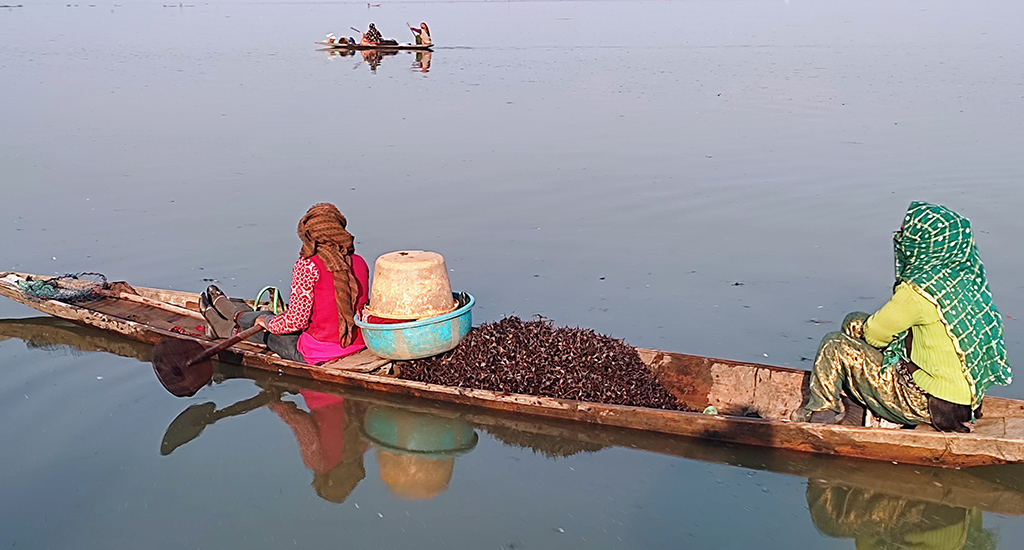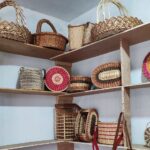Posha Akhtar of Zurman, a sleepy village between the Wular Lake and the Himalayan mountains, leaves home way before the first rays of the sun. She is headed for the lake to harvest water chestnuts – a favourite snack in the Kashmir Valley, eaten raw or boiled.
On reaching the lake, she tosses the wooden shovel into the boat. She carefully places all the items that she would need for collecting water chestnuts (Trapa sp.) from the lake.
As she paddles into the lake, fog envelopes her, making her almost invisible. This has been Akhtar’s routine for a long time.
“I wake up at 3 am and prepare meals for the entire day before going to the lake to collect water chestnuts,” she said. “I leave when my children are asleep and can’t get them ready for school.”
If she doesn’t work her family cannot make ends meet. But this livelihood is under threat.

Collecting water chestnuts requires water. But waste dumped into the lake and excess silt are reducing the water level, making chestnut extraction difficult, especially in the winter.
Shrinking Wular Lake
Situated around 45 km from Srinagar city, Wular is one of the biggest lakes of Jammu and Kashmir and is a designated Ramsar site, deemed to be of international importance.
Identifying good water chestnut spots comes with years of practice and familiarity with the lake
But according to the Wetland International South Asia Society, the lake has lost 45% of its surface area to agriculture, encroachment and willow plantation.
Also Read | Her Story: The first Indian woman who converted polythene into ashes
The Wular Conservation and Management Authority (WCMA), which is trying to clear the silt, says 27 km2 of Wular Lake has critical levels of silt.

Most fisher people have already switched to other jobs and most chestnut harvesters are left without work.
But women like Akhtar continue to try to eke out a harvest.
Silting makes harvesting difficult
It’s a long tiresome day ahead, be it rowing the boat in shallow waters or collecting the water chestnuts.
“One has to be very skillful in rowing. Identifying good water chestnut spots comes with years of practice and familiarity with the lake,” Akhtar told Village Square.
“I remember extracting 40-50 kg of water chestnuts and fishes from the lake. Women used to contribute equally to the family income,” she added.
People create pools within the lake and then make inlets for water to enter the pool so that they can extract the chestnuts.
Dwindling women water chestnut harvesters
Siltation and degradation of the lake from dumping of waste affects the livelihood of the women harvesters from the 37 villages around the lake.

“Wular used to be the biggest source of employment for women. But each passing day the window is closing for them,” said Naseer Ahmad, 37, a fisherman activist.
The revenue department issues licenses to extract water chestnuts and on an average gets a revenue of about Rs 10 lakh annually as license fee.
Also Read | Women bear the brunt of poor healthcare in rural Kashmir
As per their records there are 2,000 licence holders this year.
“About 600 of the licence holders are women. But the number varies each year depending on availability [of water chestnuts],” said Ghulam Mohammad of the revenue department.
“The number of women licence holders used to be more than 1,000. But in the past few years their number has decreased,” he said.
Women process the chestnuts
Almost 90% of chestnuts produced in the Kashmir valley comes from Wular, according to the revenue department’s data.
While women are as much a part of harvesting the water chestnuts from the lake, they also play a large role in processing the nuts.
Fazi Begum, 45, stopped extracting water chestnuts a decade ago.
“As it was becoming difficult to earn a living from collecting the chestnuts, I decided to stay home and only process the nuts brought by others,” she said.

Processing the water chestnut is labour intensive. “We clean the water chestnuts and dry them in open air, before putting them in an oven. To process 100 kg of water chestnut we burn 100 kg of wood. This process is totally done by women,” Naseer Ahmad told Village Square.
“100 kg of final product fetches us Rs 5 lakh annually – prices being decided by middlemen – and this income includes the labour of minimum five members of a family,” he rued.
Also Read | Fetching water adds to the drudgery of J&K women
“There’s no study on the women who earn their livelihood from Wular,” said Mudasir Ahmad, project manager, WCMA.
“And there’s no specific government scheme for the women who are dependent on Wular,” he said.
The lead image shows women paddling their boat filled with the collected water chestnuts in the Wular Lake (Photo by Umer Ahmad)
Umer Ahmad is a journalist based in Pulwama, Kashmir. He writes about the environment, human rights and public policies.








